Birendra of Nepal
Birendra Bir Bikram Shah (Nepali: वीरेन्द्र वीर विक्रम शाह) (28 December 1945 – 1 June 2001) was the King of Nepal from 1972 until 2001. The eldest son of King Mahendra, he reigned until his death in the 2001 Nepalese royal massacre.
| Birendra Bir Bikram Shah Dev | |
|---|---|
.jpg.webp) King Birendra c. 1967 | |
| King of Nepal | |
| Reign | 31 January 1972 – 1 June 2001 |
| Coronation | 24 February 1975 |
| Predecessor | Mahendra |
| Successor | Dipendra |
| Born | 29 December 1945 Narayanhiti Royal Palace, Kathmandu, Nepal |
| Died | 1 June 2001 (aged 55) Narayanhiti Royal Palace, Kathmandu, Nepal |
| Consort | Aishwarya Rajya Lakshmi Devi |
| Issue | King Dipendra Princess Shruti Prince Nirajan |
| House | Shah |
| Father | King Mahendra Bir Bikram Shah Dev |
| Mother | Indra Rajya Lakshmi Devi |
| Religion | Hindu |
Personality
From a very young age, Birendra was described by his school teachers as a very kind and emotional prince. King Birendra was described as one of the few Nepalese monarchs who wanted the Nepalese people to experience real democracy. This was observed in the 2036 B.S. Janmat Sangraha (1980 Referendum) when he wanted the people to choose whether they wanted 'Multiparty Democracy' or a 'Reformed Panchayat System'. However, the leaders advocating for the democracy and historians all have claimed that the referendum was rigged.[1] After People's Movement I that resulted in few hundred deaths, he was forced to establish a constitutional monarchy in Nepal.[2]
Some historians have speculated that King Birendra's democratic views and simple nature led to the success of the People's Movement I (1990).[3] He is credited for introducing SAARC in Asia in order to strengthen the foreign relations of Nepal with the other South Asian countries.
Early life
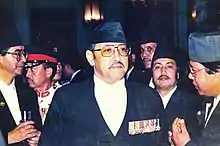
King Birendra was born at the Narayanhiti Royal Palace in Kathmandu as the eldest son of the then Crown Prince Mahendra Bir Bikram Shah Dev and his first wife, Crown Princess Indra Rajya Lakshmi Devi.[4][5]
Birendra spent eight years studying at St Joseph's School, a Jesuit school in Darjeeling, with his brother Gyanendra. On 13 March 1955 their grandfather King Tribhuvan died, and their father succeeded to the Nepalese throne. With his father's ascension Birendra became the Crown Prince of Nepal.
In 1959, Birendra enrolled at Eton College in the United Kingdom. After studying at Eton until 1964, he returned to Nepal where he began to explore the country by travelling on foot to the remote parts of the country where he lived on whatever was available in the villages and monasteries.[4] He later completed his education by spending some time at the University of Tokyo, before studying political theory at Harvard University from 1967 to 1968.[6] Birendra enjoyed traveling in his youth, and went on trips to Canada, Latin America, Africa, many parts of India, and a number of other Asian countries. He was also an art collector and supporter of Nepalese crafts people and artists, and learnt to fly helicopters.[7]
Birendra was married to Aishwarya Rajya Lakshmi Devi from the Rana family, his second cousin, on 27 February 1970.[8] The wedding, which was billed as one of the most lavish Hindu nuptial ceremonies in history, cost $9.5 million to stage.[9] King Birendra and Queen Aishwarya had three children:
- Prince Dipendra (27 June 1971 – 4 June 2001)
- Princess Shruti (15 October 1976 – 1 June 2001)
- Prince Nirajan (6 November 1978 – 1 June 2001)
Early reign
Birendra succeeded to the Nepalese throne on 31 January 1972, at the age of 27, after the death of his father King Mahendra. On his ascension he was effectively an absolute monarch, as he inherited a country where political parties were banned and he ruled through a system of local and regional councils known as panchayats.[7] Birendra resented the imputation that he was an absolute monarch, maintaining that he presided over a democracy in which representatives to the assembly were indirectly elected and saying that his poor and backward country could not afford a democracy based on party politics and that it needed firm and decisive government.[10] His first trips abroad as king were to India in October 1973 and China two months later [11] as he believed that Nepal, sandwiched between the two Asian powers, should have good relations with both.[12]
Coronation in 1975
After his father's (King Mahendra) death in 1972, King Birendra consulted his court astrologers, who advised him to delay his coronation for three years, with the most auspicious moment for his crowning being at 8:37 am precisely on 4 February 1975. Soon after dawn on that day, King Birendra was driven to the temple of his ancestral palace, the Hanuman Dhoka ("Gate of Hanuman"). There he was smeared with mud taken from various symbolic places - the bottom of a lake, the tusk of an elephant, a mountain, the confluence of two rivers and the doorstep of a prostitute's house. Then, with Queen Aishwarya beside him, he was cleansed with butter, milk, yogurt and honey as priests chanted praises and salutations.
The coronation ceremony was attended by statesmen and political leaders from 60 nations, with the Prince of Wales representing the British Royal Family. The King's personal guests included his former housemaster at Eton, Peter Lawrence, three other masters and 15 old boys. At the ordained time, the chief priest placed on the King's head the emerald green crown, encrusted with jewels and adorned with feathers from a bird of paradise.
On the auspicious occasion of his coronation, the King announced that he had ordered his government to make primary education available and free for every child, but disappointed those Nepalis who hoped that he would promise progress towards democracy.[13][14][15][16]
Zone of Peace Proposition
King Birendra announced of Nepal Zone of Peace proposition during his coronation ceremony reception. He formally asked the international community to endorse his proposal that the United Nations should declare Nepal a ZoP, to give a new dimension to Nepalese stance for non-aligned movement.
1980 referendum
In an attempt to maintain the panchayat system of government prominent leaders of the Nepali Congress Party were arrested.[7] Because of the growing pro-democracy movement Birendra announced that a referendum to decide between a non-party and a multi-party system would be held. The referendum was held in May 1980 with the non-party system winning by a margin of 55% to 45%.[12] During the 1980s the restraints that had been imposed on political organisations started to ease, and liberal student-led groups started to demand constitutional change in Nepal.[6][17]
He was appointed as a British Field Marshal in 1980.
Democratic era
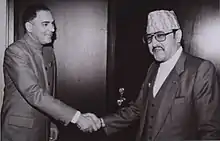
In 1990, a series of strikes and pro-democracy riots broke out in Nepal. Because of the rioting, King Birendra lifted the ban on political parties and agreed to become a constitutional monarch in April 1990. He appointed an independent Constitution Recommendation Commission to represent the main opposition factions and to prepare a new constitution to accommodate their demands for political reform. The commission presented him with the draft of the proposed constitution on 10 September 1990. The new constitution would make Birendra head of state of a constitutional monarchy with a system of multiparty democracy. The draft constitution was approved by the Prime Minister Krishna Prasad Bhattarai and his cabinet and so, on 9 November 1990, Birendra promulgated the new constitution transforming Nepal into a constitutional monarchy. King Birendra appointed an interim government to pave the way for elections. To head this he chose Krishna Prasad Bhattarai, who he had imprisoned for several years. In a discussion on BBC radio, Krishna Prasad Bhattarai spoke of King Birendra's impeccable personal manners and courtesy and his equally impeccable role as a constitutional monarch.[18][19]
However, the quarrels between various political parties and numerous social problems led to the Nepalese Civil War, a conflict between Maoist rebels and government forces, which lasted from 1996 until 2006.
Death

The stability of Nepal was threatened even more when Birendra and his family (including Queen Aishwarya) were massacred at a royal dinner on 1 June 2001.
Almost all of the royal family members were killed in the massacre except Gyanendra Shah, Birendra's younger brother. Dipendra was proclaimed king but died a few days later of self-inflicted gunshot wounds sustained in the massacre. Consequently Gyanendra was inducted as king. Dipendra's body was cremated after his funeral.[20]
Eyewitness reports and an official investigation (carried by a two-man committee made up of the Chief Justice of the Supreme Court Keshav Prasad Upadhaya and the Speaker of the House of Representatives Taranath Ranabhat),[21] confirmed that Dipendra was the gunman. Detailed investigation is impossible as the "Tribhuvan Sadan" (the building where the massacre occurred) was demolished by the Gyanendra government which made Gyanendra a most unpopular king.[22][23][24][25]
| Styles of His Majesty King Birendra Bir Bikram Shah Dev | |
|---|---|
.svg.png.webp) | |
| Reference style | His Royal Majesty |
| Spoken style | Your Royal Majesty |
| Alternative style | Sir |
Titles and honours
- National orders
 Sovereign of the Order of Nepal Pratap Bhaskara
Sovereign of the Order of Nepal Pratap Bhaskara Sovereign of the Order of Ojaswi Rajanya
Sovereign of the Order of Ojaswi Rajanya Sovereign of the Order of Nepal Taradisha
Sovereign of the Order of Nepal Taradisha Sovereign of the Order of Tri Shakti Patta
Sovereign of the Order of Tri Shakti Patta Sovereign of the Order of Gorkha Dakshina Bahu
Sovereign of the Order of Gorkha Dakshina Bahu- Most Glorious Mahendra Chain
 Recipient of the King Mahendra Investiture Medal (02/05/1956)
Recipient of the King Mahendra Investiture Medal (02/05/1956)
- Foreign orders
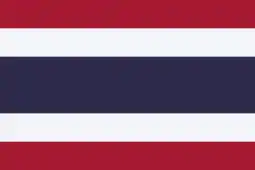 Thailand:
Thailand:
_ribbon.svg.png.webp) Collar of Order of the Rajamitrabhorn, (1979)
Collar of Order of the Rajamitrabhorn, (1979)
 Denmark:
Denmark:
 Knight of the Order of the Elephant, (17 October 1989)
Knight of the Order of the Elephant, (17 October 1989)
 Japan:
Japan:
 Collar of the Order of the Chrysanthemum, (1975)
Collar of the Order of the Chrysanthemum, (1975)
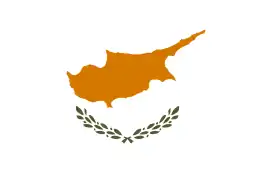 Cyprus:
Cyprus:
_-_ribbon_bar.gif) Collar of the Order of Makarios III of Cyprus, (1980)
Collar of the Order of Makarios III of Cyprus, (1980)
.svg.png.webp) Kingdom of Laos:
Kingdom of Laos:
 Collar of the Order of the Million Elephants and the White Parasol, (1970)
Collar of the Order of the Million Elephants and the White Parasol, (1970)
 Netherlands:
Netherlands:
 Knight of the Order of the Gold Lion of the House of Nassau, (22 March 1975)
Knight of the Order of the Gold Lion of the House of Nassau, (22 March 1975)
 France:
France:
 Grand Cross of the Legion of Honour, (02/05/1983)[26]
Grand Cross of the Legion of Honour, (02/05/1983)[26]
 Germany:
Germany:
 Grand Cross Special Class of the Order of Merit of the Federal Republic of Germany, (1986)
Grand Cross Special Class of the Order of Merit of the Federal Republic of Germany, (1986)
 Spain:
Spain:
 Collar of the Royal Order of Charles III, (19 September 1983)[27]
Collar of the Royal Order of Charles III, (19 September 1983)[27]
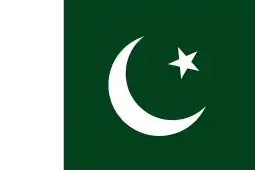 Pakistan:
Pakistan:
 Nishan-e-Pakistan, (1983)
Nishan-e-Pakistan, (1983)
 Romania:
Romania:
 Grand Cross of the Order of the Star of Romania, (1975)
Grand Cross of the Order of the Star of Romania, (1975)
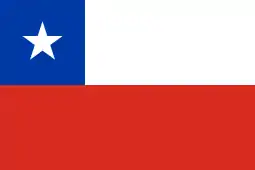 Chile:
Chile:
 Grand Cross with Collar of the Order of Merit of Chile (1989)
Grand Cross with Collar of the Order of Merit of Chile (1989)
 Finland:
Finland:
 Grand Cross with Collar of the Order of the White Rose, (1988)
Grand Cross with Collar of the Order of the White Rose, (1988)
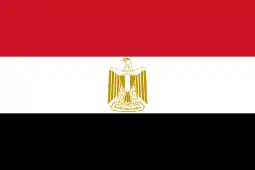 Egypt:
Egypt:
 Collar of the Order of the Nile, (1974)
Collar of the Order of the Nile, (1974)
.svg.png.webp) Yugoslavia:
Yugoslavia:
 Great Star of the Order of the Yugoslav Star, (2 February 1974)
Great Star of the Order of the Yugoslav Star, (2 February 1974)
.svg.png.webp) Romania:
Romania:
 Knight Grand Cross of the Order of 23 August (1987)
Knight Grand Cross of the Order of 23 August (1987)
 United Kingdom:
United Kingdom:
 Recipient of the Royal Victorian Chain (23 February 1975)
Recipient of the Royal Victorian Chain (23 February 1975)
- Association honours
 Japan: Golden Pheasant Award of the Scout Association of Japan, (1978)
Japan: Golden Pheasant Award of the Scout Association of Japan, (1978)
Style
H.M. Svasti Sri Giriraja Bahadur Shah Bahadur Shamsher Jang Devanam Sada Samara Vijayinam, King of Nepal, Royal Victorian Chain (23 February 1975)
References
- https://www.kullabs.com/classes/subjects/units/lessons/notes/note-detail/1971
- "Nepal's King Gives Way to Multiparty Democracy". The New York Times. 11 November 1990.
- Katawal, Rookmangud (2014). Aatmakatha ["Autobiography"] (in Nepali) (paperback ed.). Nepal. ISBN 978-9937874076.
- "King Birendra of Nepal". Daily Telegraph. 23 August 2001. Retrieved 21 July 2008.
- "The Late King Birendra Bir Bikram Shah - Childhood Picture".
- "Birendra: Nepal's monarch of change". BBC. 2 June 2001. Retrieved 21 July 2008.
- Crossette, Barbara (3 June 2001). "Birendra, 55, Ruler of Nepal's Hindu Kingdom". New York Times. Retrieved 21 July 2008.
- Mainali, Pramod (2000). Milestones of History. p. 111. ISBN 99946-960-4-1.
- "Marriage of Convenience". Time Magazine. 9 March 1970. Retrieved 21 July 2008.
- Tully, Mark (23 April 2002). "The late King Birendra of Nepal". CNN. Retrieved 21 July 2008.
- "King Birendra's Historic China Visit". Archived from the original on 23 July 2015. Retrieved 23 July 2015.
- Malhotra, Inder (4 June 2001). "King Birendra of Nepal". The Guardian. Retrieved 21 July 2008.
- "Coronation in 1975, Jean Pierre Laffont, 89 images".
- "1975 King Birendra Crowned". 24 March 2019.
- "NEPAL / ROYAL: Coronation of King Birendra 24 May 1975".
- "Telegraph". 3 June 2001.
- "King Birendra Credentials".
- "The Constitution of 1990". Country Studies. Retrieved 21 July 2008.
- Malhotra, Inder (4 June 2001). "King Birendra of Nepal A ruler much loved by his people, he bowed to popular will and surrendered absolute power". The Guardian.
- West, Julian (2 June 2001). "Nepal's royal killer is named King as his parents are cremated".
- Nepal massacre inquiry begins, at long last Archived 17 September 2006 at the Wayback Machine
- "Prince blamed for Nepal massacre". BBC News. 14 June 2001. Retrieved 6 February 2011.
- "Nepal: Is India behind the Nepalese Royal Family massacre?".
- "Birendra Bir Bikram Shah Dev King of Nepal".
- "Dipendra kicked his father after he shot him". Archived from the original on 2 July 2015. Retrieved 23 July 2015.
- "Bilateral relations". La France au Népal. Archived from the original on 18 October 2015. Retrieved 8 September 2018.
- "Boletín Oficial del Estado" (PDF). Retrieved 8 September 2018.
Album of Late king Birendra Bir Bikram Shah Dev by Narayan Prasad Shiwakoti: Published on 1995 AD – Election
| Regnal titles | ||
|---|---|---|
| Preceded by Mahendra |
Crown Prince of Nepal 1955–1972 |
Succeeded by Dipendra |
| King of Nepal 1972–2001 | ||